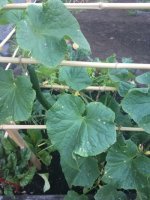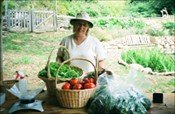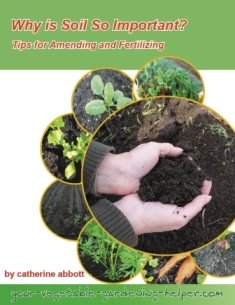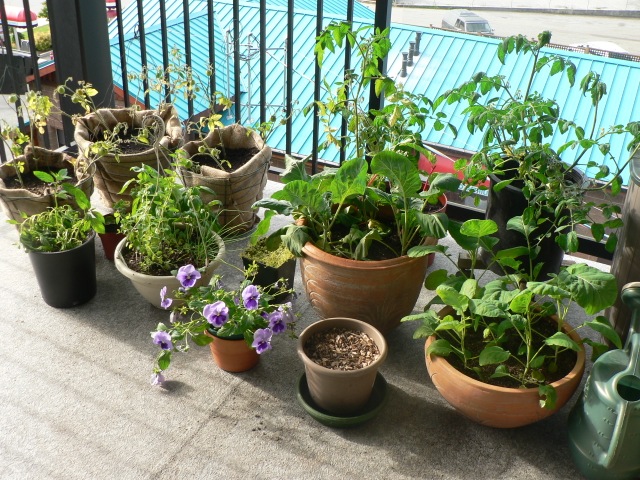Beekeepers Garden
I enjoyed my visit to a beekeepers garden in Castlegar, British Columbia
Canada. This small city in the southern part of the province has a long history, beautiful scenery,
charm and most of all beautiful vegetable gardens.
I met with Sarah and Greg Currie who had moved here from Brooklyn New York in
2010. They came to Castlegar looking for
a better lifestyle and definitely found it. They have a beautiful garden.
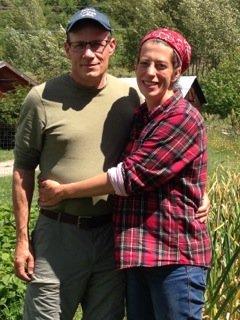 Greg and Sarah
Greg and SarahWhen they first came to the area they rented. They took time to get to know the area, the locals and then bought their beautiful piece of paradise. Their property has lots of history attached to it as the vegetable garden is on a spot where a huge Doukhobor barn stood.
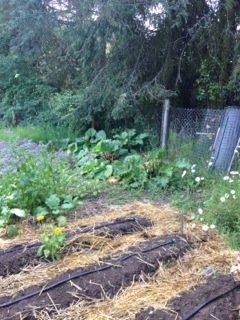 Veggie patch
Veggie patchThis
area of the province has cold weather and snow in the winter months. Looking out from their front
patio you look at Sentinal Mountain, a well known hiking area but it also has an old tale associated with it. The early settlers believed and practiced "when the snow melted from the top, it is time to plant their seeds". Their vegetables seeds are planted in
April, depending on the snow if you believe in this historic tale.
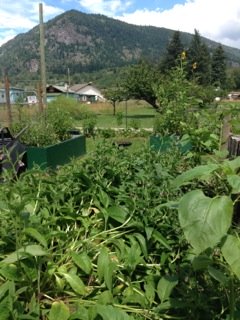 Sentinal mountain
Sentinal mountainThey have a very productive vegetable
garden that provides much of their food. When exploring the garden I saw tomatoes growing in raised beds, rows of garlic, beans, peas, lettuce,
cilantro, basil, and asparagus.
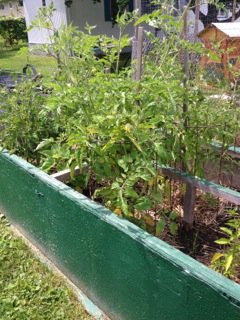 Tomatoes in raised bed
Tomatoes in raised bed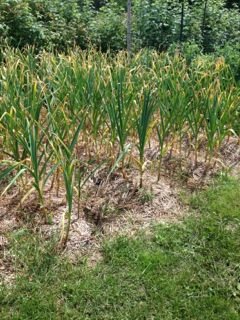 Garlic
GarlicThe veggie patch is surrounded with raspberry
and strawberry plants. Herbs and perennials are intermixed in the vegetable garden.
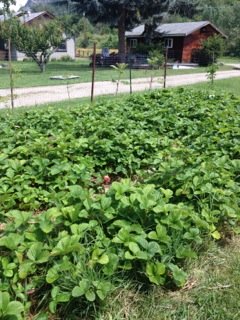 Strawberries
Strawberries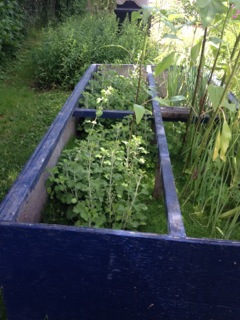 Herbs
HerbsOn the sunnier,
more sheltered side of the yard, where and old deck use to be, they are growing
cucumbers and watermelons. The old deck needed to come down and they wanted
more garden area rather than spend money on
a new deck. Every corner of their beekeepers garden is filled with food for themselves or their bees.
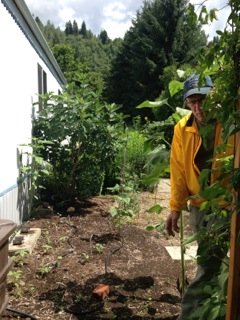 Melons and Cucumber
Melons and CucumberAs well as the productive vegetable garden, herbs and fruit trees, everywhere you look there are fabulous perennial flowers. 3 years ago, Sarah became a beekeeper, which dictates a huge part of her garden planning and plantings. Perennial flowers are planted for flowering at various times of the year, all designed to feed her bees.
Around the beekeepers garden are pots filled with
coconut husks just covered in water, a watering spot where her bees can drink
but not drown. I did not know anything
about bees but got a quick little lesson.
She feeds her bees early and late in the season and has her plants do
the rest.
Beekeepers garden needs hive.
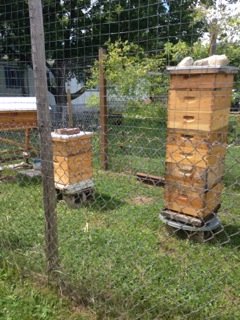 Beehives
Beehives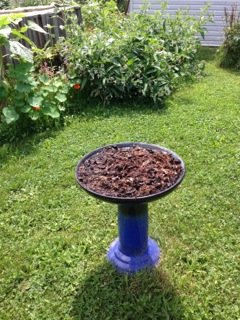 Coconut husk covered with water
Coconut husk covered with waterSarah has tonnes of different flowers growing: honeyberry, crocus, snow drops, witch hazel, lilacs, borage, lupin, wild marjoram, thyme, forsythia, tarragon, asters, white flock, clematis, comfrey, yarrow, iris, butterfly bush, clematis, purple pole beans, – and these are just the spring and summer blooms. Purple asters and white flock for the bees winter food.
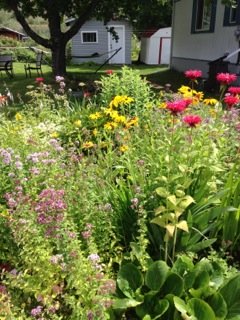
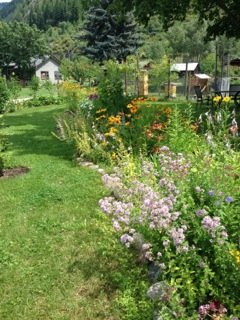
With a close knit community there is always someone dividing a perennial plant or wanting to trade. Sarah said this is how she started most of her perennials flowers. As a beekeepers garden the types of flowers she chooses is based on whether or not they will feed her bees.
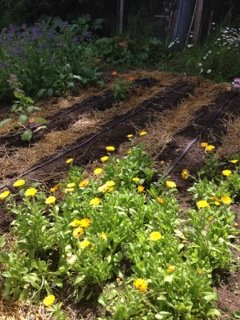
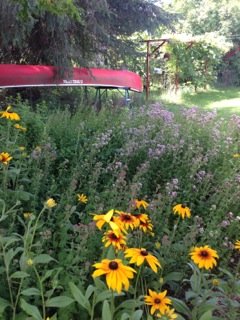
There were several large fruit trees on the property when they purchased it. Along with all the veggies and perennials Sarah and Greg have also planted more berries bushes and fruit trees - Saskatoon berries, gooseberry, Italian plum
tree, cherry trees, grapes, and fig tree. These produce summer flowers for the bees and
some wonderful fruit to enjoy.
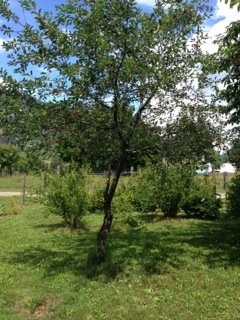
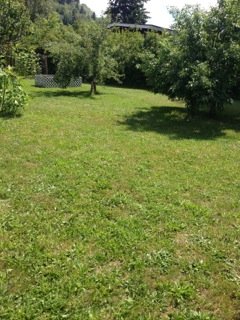
Sarah uses a 3 year rotation to plant her vegetables in her beekeepers garden, helping to keep soil and
plants happy. They have a well on the property and use a
drip irrigation system for watering. She
has divided the garden into sections and each day a certain section of the garden gets
water for a few hours.
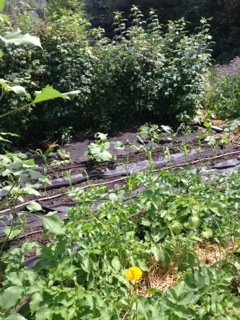 Drip irrigation
Drip irrigationShe makes her own compost – like lots of us it could be managed a bit better, which is one of their projects. She makes compost tea and like her watering schedule she gives each section of her garden a "hit" whenever there is a dry day.
She adds molasses in the compost tea.
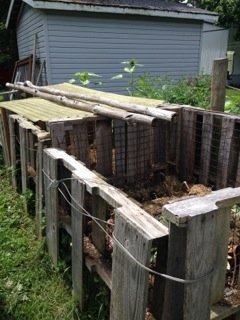 Compost bin
Compost bin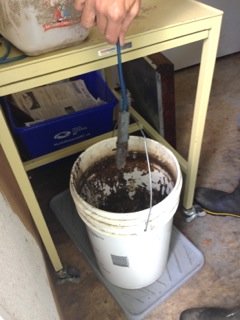 Making compost tea
Making compost teaThey fenced their yard and created a berm to keep the deer and bear out and the dog in. It will also add privacy in the future.
They have a shady back area where they hope to bring in chickens one day. There are bobcats, coyotes, weasels to consider when planning a chicken coop.
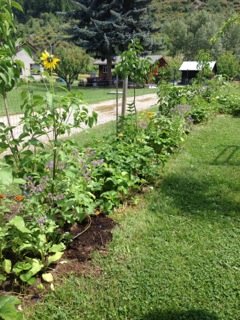 Fence and berm along the drive
Fence and berm along the drive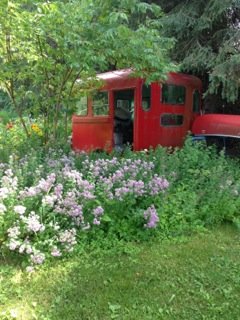 Potential chicken coop
Potential chicken coopThe front part of their property was turned over to create another garden area. They have plans to turn more of the front lawn into garden beds. They have used the lasagna garden method as well as digging up the sod for other areas, both are lots of work so they are not sure which way they will go to expand this area.
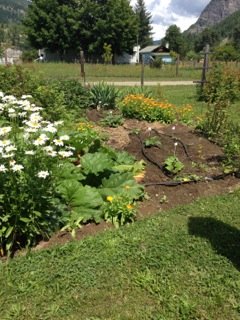 Front garden
Front gardenThey are committed to creating a sustainable lifestyle, which in my opinion they are doing very well. Greg teaches at the local college, which is within walking distance from their property and Sarah is the full time gardener. They grow, bake with, can, and freeze most of the veggies and fruit they grow. They save on the food budget but work very hard to make it happen.
Sarah shared she lost lots of weight before moving here and her new lifestyle has helped her keep it off.
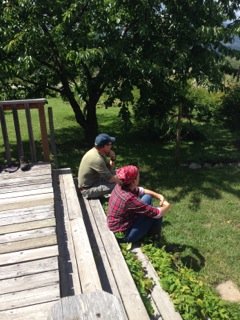
I had a wonderful visit with Sarah and Greg. I left feeling inspired and with a tasty homemade crumble to eat along my journey. Thank you for inviting me into your garden.
Return from Beekeepers Garden to Northern Vegetable Garden
Recent Articles
-
Vegetable Gardening Frustrations: Lessons for a Better Harvest
Oct 29, 24 07:37 PM
Every vegetable gardener knows that while the rewards are sweet, the vegetable gardening frustrations can be a bit bitter. -
Small Space Vegetable Gardening
Sep 23, 24 05:06 PM
Small Space Vegetable Gardening - Tips for growing vegetables in small spaces. -
Why Fall Gardening?
Aug 16, 24 12:24 PM
Fall Gardening: A guide to a Bountiful Harvest.
